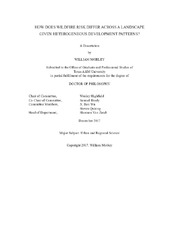| dc.description.abstract | This study explores the variation in wildfire risk from different development patterns. The analysis tests how an assortment of variables within the fire risk framework are affected by differing lateral development types. The study area covered Bastrop and Travis counties located in Texas. Two time periods were used in the assessment, 2001 and 2012.
Lateral development was categorized into five categories: infill, radial, isolated, clustered, and linear. Within the fire risk framework, fire severity, ignition probability, and burn probability were assessed for the study area. Maximum Entropy was used to spatially predict ignition probability. Burn probability and conditional flame length were simulated using the Minimum Travel Time algorithm.
Ignition probability variation was assessed using a one-way ANOVA and post hoc analysis. Burn probability and conditional flame length analyses were more robust. One-way ANOVAs and post hoc analyses were used to differentiate variation among lateral development types. Generalized Methods of Moments were used to estimate changes in burn probability and conditional flame length across time. Finally, the simulation’s fire perimeters were analyzed for initiation and exposure using social network analysis techniques.
Analyses found that outlying development patterns: isolated, clustered, linear, were at higher wild fire risk than infill and radial development. However, most simulated fires initiated nearest radial development. Being closer to a road increased the likelihood of ignition, but increases in road density decreased burn probability. Changes in fuel loading had a positive correlation with changes in conditional flame length and burn probability. The analysis suggests that increasing populations in the wildland-urban interface are increasing their risk. Policies that reduce the outlying development patterns will reduce risk for the community. | en |


